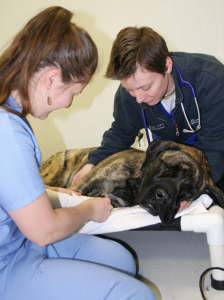Veterinary Pain Management

Pain Management in Veterinary Medicine
Pain management in animals is recognized as an integral aspect of veterinary practice that offers many advantages to patients. Anyone who has experienced a painful episode is well aware of the discomfort involved. If not addressed appropriately, pain in animals is similarly uncomfortable, and leads to delayed healing and exaggerated stress in already sick or injured patients. Untreated pain potentially results in further injury, illness, and severe behavioral changes similar to human depression and dysfunction. Major advancements within the veterinary profession over the last decade have enabled us to respect pain not only as a serious side effect of many medical and surgical procedures, but also as a significant disease in and of itself!
The medical term for pain relief is “analgesia”, and typically accompanies anesthesia in a surgical patient. However, pain relief should be included in any pet’s problem resolution, whether surgical, medical or acute (emergency). With pain relief or analgesia, significantly fewer adversities such as inflammation, sepsis, cardiac dysrrhythmias, pulmonary disease, clotting dysfunctions, and gastrointestinal issues arise from both acute and chronic illness. Pain relief should be viewed as a standard of veterinary care in healing, as antibiotics for bacterial infections and surgical techniques to correct developmental or traumatic problems are viewed.
pet’s problem resolution, whether surgical, medical or acute (emergency). With pain relief or analgesia, significantly fewer adversities such as inflammation, sepsis, cardiac dysrrhythmias, pulmonary disease, clotting dysfunctions, and gastrointestinal issues arise from both acute and chronic illness. Pain relief should be viewed as a standard of veterinary care in healing, as antibiotics for bacterial infections and surgical techniques to correct developmental or traumatic problems are viewed.
Your Pet’s Pain Management Team
Classically, anesthesiologists have focused on perioperative or surgical care, safely maintaining the vital functions of the body and relieving pain associated with more invasive procedures. However, today’s human and veterinary anesthesiologists also function as intricate leaders of a pain service team that includes surgeons, oncologists, internal medicine specialists, veterinary nurses, technicians, and physical therapists. With their combined expertise, they work together to identify the causes of pain in our animal patients, and tailor a plan for effective treatment.
The human pain specialist often holds advanced training (fellowships, residencies, certifications) in osteopathy, interventional procedures, anesthesiology, outpatient pain treatment, physical therapy and rehabilitation, and possibly a complementary therapy such as acupuncture or chiropractic.
The veterinary pain specialist is typically a doctor who has received advanced training in pain management, offered either through academic or non academic routes. They may be a general practitioner or a specialist, and frequently if they are the latter, they are surgeons, anesthesiologists or complementary practitioners (acupuncturists, chiropractors).
Evaluating Pain in Veterinary Patients
Identifying pain in animals is slightly more difficult than it is in humans. Your pain specialist relies on your observations at home as much as he or she relies on objective data from diagnostic tests. In evaluating your pet’s pain, the clinician will develop an in-depth history surrounding your pet’s particular problem. This will include a thorough physical examination, a complete review of medical records and your description of your pet’s problem(s). Often, supplemental diagnostic studies, such as detailed questionnaires concerning your pet’s daily schedule, function, and surroundings, including (when possible) videos of your pet displaying the pain behaviors at home. Observational data is rounded out with imaging (ultrasound, CT, MRI, radiographs, fluoroscopy), function testing (force plate or lameness scoring), and local anesthetic tests help to pinpoint sources of pain and underlying problems.
Painful Diseases, Conditions and Syndromes
Outpatient veterinary pain management centers and practitioners are actively taking a role in treating many “problematic” issues which plague veterinary patients. Examples of some types of painful diseases, conditions, or syndromes which are typically seen by veterinary pain services include:
- Degenerative diseases (e.g., osteoarthritis, Cushings disease)
- Post surgical orthopedic problems (Post cruciate lameness or dysfunction)
- Neurologic impairments (disc protrusion or extrusion, nerve entrapments, embolic events)
- Chronic musculoskeletal laxity secondary to medical disease (Cushings tendon or ligamentous strains)
- Oncologic gastrointestinal, radiation, surgical side effects
- Traumatic recovery illness (post HBC orthopedic and soft tissue dysfunction or impairment)
- Dermatologic diseases (hotspot, ulcerative, diffuse dermatolgic, otic, mucosal or burn pain)
- Intensive care cardiac and pulmonary disease patients (post pneumonia recovery patients)
- Postoperative or postchemotherapy gastrointestinal disease (nausea, vomiting,constipation)
- End stage or hospice therapy
- Palliative care
Animals who are in need of pain management typically require balancing of their medications, optimization of nutrition, addition of supplements, appropriate exercise and/or mobilization assistance (splints, orthotics, braces, carts, etc). Often, these are the cases that “fall through the cracks” of regular medical or surgical correction, and despite routine medical or surgical intervention, still hurt, are disabled, or have reduced quality of life.
Written by Andrea Looney, DVM, DACVAA, CCRP, DACVSMR